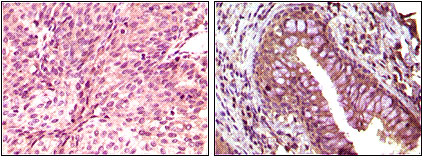EphB6 Monoclonal Antibody
- Catalog No.:YM0235
- Applications:WB;IHC;IF;ELISA
- Reactivity:Human
- Target:
- EphB6
- Fields:
- >>Axon guidance
- Gene Name:
- EPHB6
- Protein Name:
- Ephrin type-B receptor 6
- Human Gene Id:
- 2051
- Human Swiss Prot No:
- O15197
- Mouse Swiss Prot No:
- O08644
- Immunogen:
- Purified recombinant fragment of EphB6 expressed in E. Coli.
- Specificity:
- EphB6 Monoclonal Antibody detects endogenous levels of EphB6 protein.
- Formulation:
- Liquid in PBS containing 50% glycerol, 0.5% BSA and 0.02% sodium azide.
- Source:
- Monoclonal, Mouse
- Dilution:
- WB 1:500 - 1:2000. IHC 1:200 - 1:1000. ELISA: 1:10000.. IF 1:50-200
- Purification:
- Affinity purification
- Concentration:
- 1 mg/ml
- Storage Stability:
- -15°C to -25°C/1 year(Do not lower than -25°C)
- Other Name:
- EPHB6;Ephrin type-B receptor 6;HEP;Tyrosine-protein kinase-defective receptor EPH-6
- Molecular Weight(Da):
- 111kD
- References:
- 1. Kazushige Ogawa, Hiroki Wada, Noriyoshi Okada J Cell Sci. 2006 Feb 1;119(Pt 3):559-70.
2. Hiroshi Matsuoka, Hiroya Obama, Meghan L. Kelly J Biol Chem. 2005 Aug 12;280(32):29355-63.
- Background:
- This gene encodes a member of a family of transmembrane proteins that function as receptors for ephrin-B family proteins. Unlike other members of this family, the encoded protein does not contain a functional kinase domain. Activity of this protein can influence cell adhesion and migration. Expression of this gene is downregulated during tumor progression, suggesting that the protein may suppress tumor invasion and metastasis. Alternative splicing results in multiple transcript variants. [provided by RefSeq, Jul 2013],
- Function:
- domain:The protein kinase domain is predicted to be catalytically inactive. Its extracellular domain is capable of promoting cell adhesion and migration in response to low concentrations of ephrin-B2, but its cytoplasmic domain is essential for cell repulsion and inhibition of migration induced by high concentrations of ephrin-B2.,function:Kinase-defective receptor for members of the ephrin-B family. Binds to ephrin-B1 and ephrin-B2. Modulates cell adhesion and migration by exerting both positive and negative effects upon stimulation with ephrin-B2. Inhibits JNK activation, T cell receptor-induced IL-2 secretion and CD25 expression upon stimulation with ephrin-B2.,PTM:Ligand-binding increases phosphorylation on tyrosine residues. Phosphorylation on tyrosine residues is mediated by transphosphorylation by the catalytically active EPHB1 in a ligand-independent manner. Tyrosine phosphorylat
- Subcellular Location:
- Membrane; Single-pass type I membrane protein.; [Isoform 3]: Secreted .
- Expression:
- Expressed in brain. Expressed in non invasive breast carcinoma cell lines (at protein level). Strong expression in brain and pancreas, and weak expression in other tissues, such as heart, placenta, lung, liver, skeletal muscle and kidney. Expressed in breast non invasive tumors but not in metastatic lesions. Isoform 3 is expressed in cell lines of glioblastomas, anaplastic astrocytomas, gliosarcomas and astrocytomas. Isoform 3 is not detected in normal tissues.
- June 19-2018
- WESTERN IMMUNOBLOTTING PROTOCOL
- June 19-2018
- IMMUNOHISTOCHEMISTRY-PARAFFIN PROTOCOL
- June 19-2018
- IMMUNOFLUORESCENCE PROTOCOL
- September 08-2020
- FLOW-CYTOMEYRT-PROTOCOL
- May 20-2022
- Cell-Based ELISA│解您多样本WB检测之困扰
- July 13-2018
- CELL-BASED-ELISA-PROTOCOL-FOR-ACETYL-PROTEIN
- July 13-2018
- CELL-BASED-ELISA-PROTOCOL-FOR-PHOSPHO-PROTEIN
- July 13-2018
- Antibody-FAQs
- Products Images

- Western Blot analysis using EphB6 Monoclonal Antibody against Jurkat (1) and NIH/3T3 (2) cell lysate.

- Immunohistochemistry analysis of paraffin-embedded human bladder carcinoma (left) and return carcinoma (right) tissue, showing cytoplasmic localization with DAB staining using EphB6 Monoclonal Antibody.



